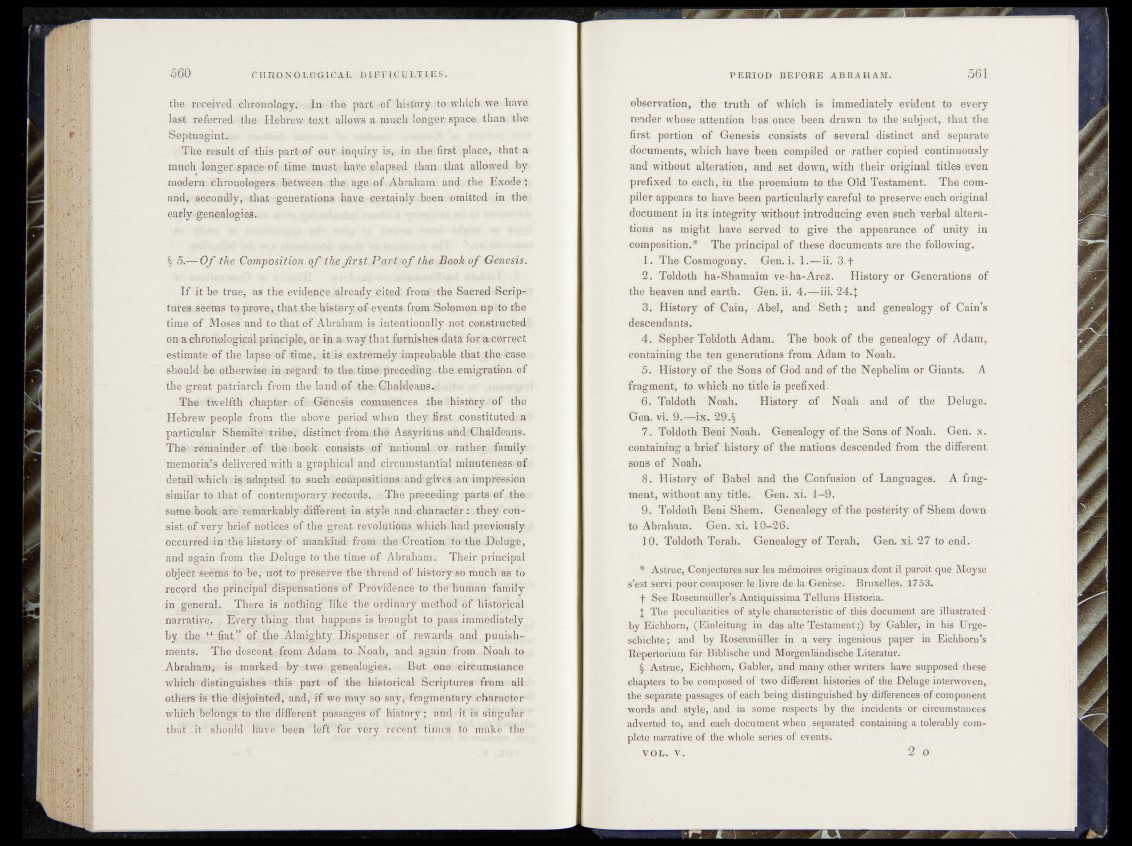
the-, .recced; 4br enologty;Ia^tbe part , - ^ f w e have-
last referred- the Hebrewrtext, allows a ..ni^b longer-apae©than- the
Septuagint.s
The result of this part .of our inquiry is, in the first place, that a
much -longer ,space? of time must - have elapsed than that allowed by
modern chronologershetween, the age of Abraham and the Ex ode*
and, secondly, that generations have certainly been omitted in th©'
early genealogies.
§ 5.—Of-tike Composition o f'the J ir s tP a r t } o f th e B o o k .o f Genesis.
If it be true, as the evitfeMeialready, Sited; fronaftthe §a®r©d«§m;ip^
tures seems to prove, that the; bistery of events frjmi SofemoB®plfo the
time of Moses1 and to that of Abraham is intentionally not construc-tedd
on a chronological.principle, or in a, way that furnishes data for correct
estimate of the lapse of time,cit is extremely improbable that theïcase
should be otherwfee in .regard to theRime^prece^ng,'tbeï®mi^atión fOf
the great patriarch from the landtof the? Chaldeans.,;
Thëu twelfth chapter vofe;GdneSis commences .the Aistteÿ.fof the
Hebrew people from the above period when they, first, :constitute(fea
particular Shemite* tribe;’ distinct from the AssyriansioMtChaldèarp.
The remainder of the book consists of national orrathet-ufaraily
memorials delivered with a graphical and circumstantial miauténess^of
detail which is adapted to such compositions, and gives-an impression
similar to that of contemporary records. The preceding parts ef , the
same- book are remarkably different in style and character : they consist
of very brief notices of the great revolutions whicb had previously
occurred in the history of mankind from the Creation to the Deluge,
and again from the Deluge to the time of Abraham. Their ^principal
object seems to be, not to preserve the thread of history so much as to
record the principal dispensations of Providence to'the htufiàh family
in.general. There is nothing like the ordinary method of histofic^l
narratiye. Every thing that happens Is brought to pass immediately,
by the, M fiat.” of the A1 mighty .Dispenser of rewards and .punishments.
The descent from Adam to Noah, and again from Noah to
Abraham, is marked hy .two- genealogies. But one cincumstance
which'distinguishes this part of the historical Scripture»'from all
others is the disjointed, and, if we-may so say, fragmentary character
which belongs to the different passage's of history ; an el it is singular ;
that ^it should have been left for very recent times to makethe'
observation, the truth of which is immediately evident to every
reader whose attention has once been drawn $® fhe subject* that the
first portion of Gouim eoosists of several distinct and separate
documents, which have been compiled or rather copied continuously
and without alteration, and set clown, with their original titles even
prefixed to each, in the proemium to the Old Testament. The compiler
appears to have been particularly careful to preserve each original
document in its integrity without introducing even such verbal alterations
as might have served to give the appearance of unity in
composition.* The principal of these documents are the following.
1. The Cosmogony. Gen. i. 1.—ii. 3.f
2. Toldoth ha-Shamaim ve-ha-Arez. History or Generations of
the heaven and earth. Gen. ii. 4ife«£ff? 24.J
3. History of Cain, Abel, and Seth; and genealogy of Cain’s
descendants.
__4. Sepher Toldoth Adam. The book of the genealogy of Adam,
containing the tfen generations from Adant to Noah.
■ ■■§* History of the Sons of God and of the Nephelim dr Giants. A
fragment, to which.no title is prefixed.
6. Toldoth Noah. History of Noah and of the Deluge.
Gen. vi. ix. 2§U|
7. Toldoth Beni Noah. Genealogy of. the Sons of Noah. Gen. x.
containing a brief history of the nations descended from the different
sons of Noah.
8. History-ef Babel and the Confusion of Language. A fragment,
without any title._ Gen, xi. 1—9.
9. Toldoth Beni Shem. Genealogy of the posterity of Shorn down
to Abraham. Gen. xi. 10-26.
10. Toldoth Terah. Genealogy of Terah. Gen. xi. 27 to end.
* Astruc, Conjectures sur les mdmoires originaux dont il paroit quefifcyse
s’est send.pour composer le livre de la Genhse. Bruxelles. 1753.
f See Rnsenmulleris Antiquissima Telluris Historia.
1 The peculiarities of style characteristic of this document are illustrated
by Eichhorn, (Einleitung in das alte Testament;^ by Gabler, in hi®. Gige-
schichte; and by Rosenffiblter in a very ingenious paper in Eiebhom’s
Repertorium fur Biblische und Morgenlandisi^e Mteratur.
§ Astruc, Eichhorn, Gabler, and many other writers have supposed these
chapters to be composed of two different histories of the Deluge interwoven,
the separate passages of each being distinguished by differences-of component
words and style, and in some respects- by the incidents or circumstances
adverted to, and each document when separated containing.a tolerabty com**
plete narrative of the whole series of events»
VOL. V. 2 o